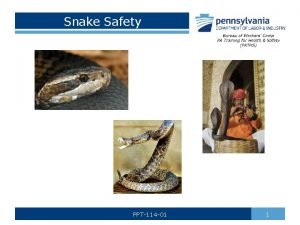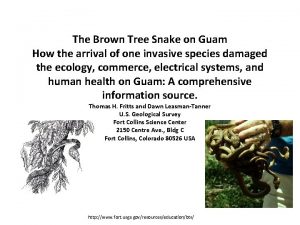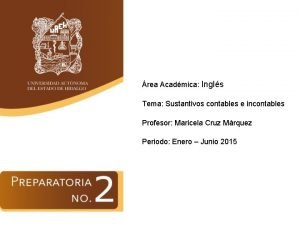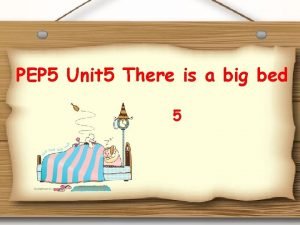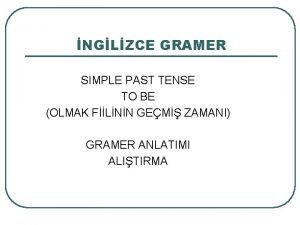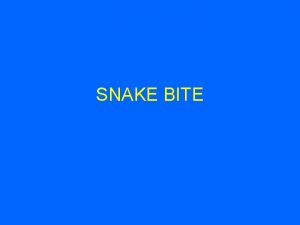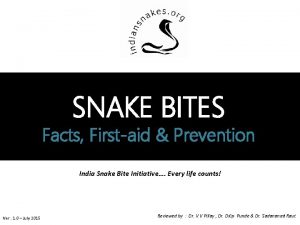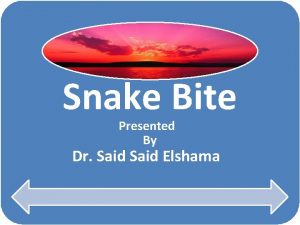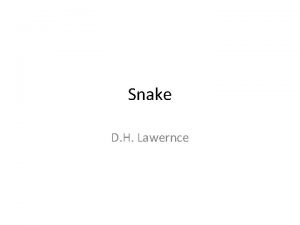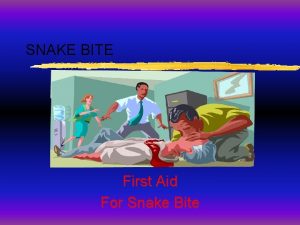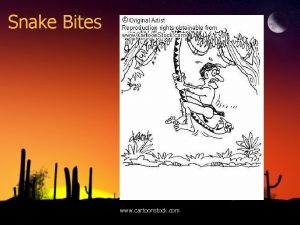Snake Safety PPT114 01 1 Snake Facts There


























- Slides: 26

Snake Safety PPT-114 -01 1

Snake Facts • There are over 3, 000 species of snakes. • Every year there are nearly 7, 000 snake bites. • Snake’s scales are made up of Keratin, which is the same thing that our fingernails are made from. • The Hognose, Grass snake and the Spitting Cobra will fake death when feeling threatened. They flip onto their backs, open their mouths, and let their tongue flop out. And they will let out some smelly stuff from their anal gland. PPT-114 -01 2

Snake Facts • Most snakes are not aggressive. They will usually retreat from danger. However if they start to feel threatened, they will strike. • Snakes are cold-blooded and rely on their surroundings for warmth. • A reticulated python, named Colossus, was the largest snake that ever lived in a zoo. She lived at the Pittsburgh Zoo in Pennsylvania and was 28 ½ feet long and weighed 320 pounds. PPT-114 -01 3

Snakes in Pennsylvania • There are 21 species of snakes in Pennsylvania. • 18 are nonvenomous • 3 are venomous PPT-114 -01 4

Poisonous Snakes of PA • Northern Copperhead • Eastern Massasauga • Timber Rattle Snake ü Yellow phase ü Black phase PPT-114 -01 5

Nonvenomous Snakes of PA • Eastern Hognose • Northern Black Racer • Eastern Ribbon • Eastern Smooth Earth • Eastern Garter PPT-114 -01 6

Nonvenomous Snakes of PA • Northern Ringneck • Eastern Worm • Shorthead Garter • Eastern Milk • Eastern Rat PPT-114 -01 7

Nonvenomous Snakes of PA • Queen • Rough Green • Smooth Green PPT-114 -01 8

Venomous vs Nonvenomous • In PA all venomous snakes have slit-like pupils, similar to a cat’s eye. • Nonvenomous snakes have round pupils, like humans. PPT-114 -01 9

Venomous vs Nonvenomous • All 3 venomous snakes in PA belong to the pit viper family. • A pit viper snake has a deep pit on each side of its head that it uses to detect the warmth of nearby prey. • This helps the snakes to locate food, especially while hunting at night. • These pits are located between the eyes and the nostril. Nostril Pit PPT-114 -01 10

Venomous vs Nonvenomous • If you find a shedded snake skin, look at the scales on the underside. Ø Single Row – if they are in a single row all the way to the tip of its tail – venomous snake. Ø Double Row – if the scales split into a double row – nonvenomous snake. PPT-114 -01 11

Venomous vs Nonvenomous • Venomous snakes store their venom in a sac on each side of their head (triangular shape). • However, some nonvenomous snakes can also flatten their heads, so do not use head shape alone to identify a venomous snake. PPT-114 -01 12

Snake Tips • Leave snakes alone – almost all cases of snake bites occur when people attempt to catch, pick up, or kill snakes. • Use specialty snake handling tools when picking up or transporting any snakes that you cannot identify. • Wear snake boots and/or snake gaiters on your feet and legs when walking through snake country. PPT-114 -01 13

Snake Tips • Buy a snake trap. • Hire a professional snake removal expert. • Learn how to identify venomous and nonvenomous snakes. • Do not try to kill snakes. Ø Faster than you think Ø Hard to kill Ø Wild when injured Ø Strike after they appear or play dead PPT-114 -01 14

Preventing Snake Bites At Work • Keep grass cut short. • Wear long pants and boots. Tuck your pant legs into your boots • Wear protective gloves when grabbing things off of the ground. • Keep bushes, shrubs and flowers a few feet away from sidewalks or other walkways. PPT-114 -01 15

Preventing Snake Bites At Work • Never leave food sitting out. • Do not keep materials piled up outside (wood, brick piles, etc. . ) • If you see a snake while working back up slowly and call the animal control center. PPT-114 -01 16

First Aid For Snake Bites • Call for medical attention immediately. • Avoid caffeine or alcohol • Keep the bite below your heart. • Remove any clothing around the bite. • Clean the area gently but do not flush. • Wrap the area but do not restrict blood flow to the site. PPT-114 -01 17

First Aid For Snake Bites • In the movies they cut the area or try to suck out the venom. Doing this in real life could cause an infection in the area. • Never attempt to capture the snake that bit you. It could strike again since it is already agitated. • Try to remember what the snake looks like. This will help the doctors treat the bite. PPT-114 -01 18

Symptoms of a Snake Bite • Intense pain in the area • Swelling • Bleeding • Shortness of breath • Weakness • Dizziness • Fever PPT-114 -01 19

Symptoms of a Snake Bite • Numbness • Nausea • Sweating • Increased heart rate • Blurred vision • Fainting PPT-114 -01 20

Snake Feces • Smells and often brown • Oblong, liquid excretion with a white cap • Often mistaken for that of a bird – bird feces will appear much whiter • Size will tell you size of the snake • May contain scales, feathers or bones • Contains salmonella bacteria which is linked to severe illness in humans and possibly death. PPT-114 -01 21

Snakes in the Attic • Rat snakes can live in the attic – can climb and fit in very tiny holes. • Rats leave a distinct odor that snakes follow. • Look for snake skins and droppings. • More active in the warmer months. • Eliminate the rodents and seal shut any gaps or holes. PPT-114 -01 22

Summary § Know the environment you are entering § Determine the snake hazards which may exist § Know the correct actions to take should you encounter snakes § Ensure you have the ability to render First Aid for bites § If encountering snakes, give them a wide birth and do not antagonize the encounter. PPT-114 -01 23

Questions PPT-114 -01 24

Contact Information Health & Safety Training Specialists 1171 South Cameron Street, Room 324 Harrisburg, PA 17104 -2501 (717) 772 -1635 RA-LI-BWC-PATHS@pa. gov Like us on Facebook! https: //www. facebook. com/BWCPATHS PPT-114 -01 25

Bibliography http: //www. cdc. gov/niosh/topics/snakes/ PPT-114 -01 26
 Snake
Snake Where did the brown tree snake come from
Where did the brown tree snake come from Multiplication facts and division facts
Multiplication facts and division facts Lab safety facts
Lab safety facts Tema there is there are
Tema there is there are There is there are part of speech
There is there are part of speech There is there are negative form
There is there are negative form There are there is
There are there is There aren't some cakes
There aren't some cakes There is there are
There is there are The committee debate these questions carefully
The committee debate these questions carefully Here there over there
Here there over there A an and some
A an and some Pepper contable o incontable
Pepper contable o incontable There is and there
There is and there There was there were ile ilgili cümleler
There was there were ile ilgili cümleler Negetive sentences
Negetive sentences There is there are
There is there are There
There There's and there are
There's and there are If there is no struggle there is no progress explanation
If there is no struggle there is no progress explanation What is catzoc
What is catzoc Safety care certification
Safety care certification Personal safety vs process safety
Personal safety vs process safety Safety assessment for ind safety reporting
Safety assessment for ind safety reporting Basic safety orientation
Basic safety orientation Basic safety construction site safety orientation
Basic safety construction site safety orientation
